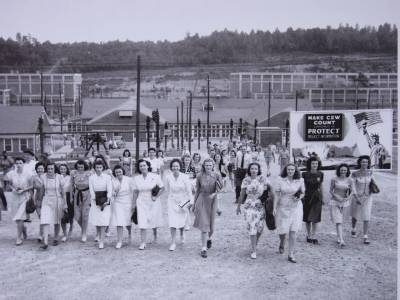The Y-12 Plant in Oak Ridge used the electromagnetic separation method, developed by Ernest Lawrence at University of California-Berkeley, to separate uranium isotopes.
Electromagnetic Separation
The electromagnetic separation method was the most developed of the potential ways to produce fissile material at the start of the Manhattan Project. Ernest O. Lawrence, working at the University of California-Berkeley, determined that when an electrically-charged atom was placed in a magnetic field, it would trace a circular path with a radius determined by the atom’s mass. U-235 was lighter than U-238 and could be isolated by placing a collecting pocket in its path.

Calutrons & Racetracks
The massive Y-12 plant at Oak Ridge was designed to carry out on a large scale what Lawrence had successfully done in his Berkeley lab. While the machines in California were called cyclotrons, at Y-12 they were dubbed “calutrons” from CALifornia University cycloTRONs. Ground was broken for the Y-12 Plant in Tennessee on February 1, 1943, with the first calutron building construction beginning February 18, 1943.
There were 1,152 calutrons at Y-12 which worked in tandem to process uranium in batches. Two sizes of calutrons were used at the Y-12 Plant: Alpha (the larger machines) and Beta (for the smaller machines). Alpha I calutrons were arranged in giant ellipses called racetracks, while the Alpha II and the Beta calutrons were rectangular in arrangement. Because of wartime shortage of copper, the huge magnetic coils had to be wound with 14,700 tons of silver obtained from the U.S. Treasury.
“Calutron Girls”
Wartime labor shortages forced Tennessee Eastman Corporation to recruit young women, mostly recent high school graduates and farm girls. Even though they were not told what they were producing, the women were very adept at the controls. They worked in cubicles and were called “cubicle girls” (back then the term “calutron” was secret).
Known now as the “calutron girls,” the women proved in a week-long test to have a better feel for how to adjust the knobs to optimize production than Ph.D. physicists who were constantly fiddling with the controls.
Innovations
Despite being plagued by troubles, the Y-12 plant eventually produced the enriched uranium for the first atomic bomb. But the calutrons required an exorbitant amount of energy and over 22,000 employees. In December 1946, all of the Y-12 calutrons were shut down, except for the 36 calutrons in the Beta 3 building and the pilot units in Building 9731.
Starting in 1959, the Beta 3 calutrons were used to produce over 200 stable isotopes used for cancer treatment, medical diagnostics, nonproliferation, and other applications. In 1998, production was shut down but the control room and other portions of the facility remain as they were in 1945.




